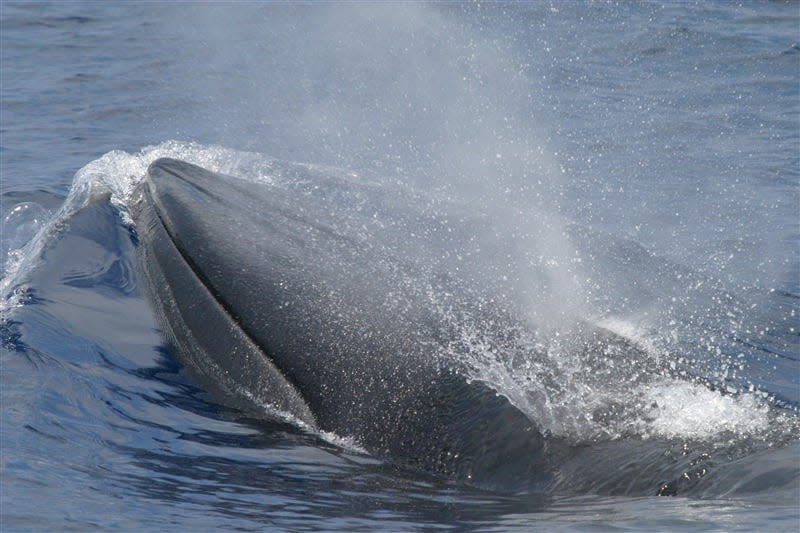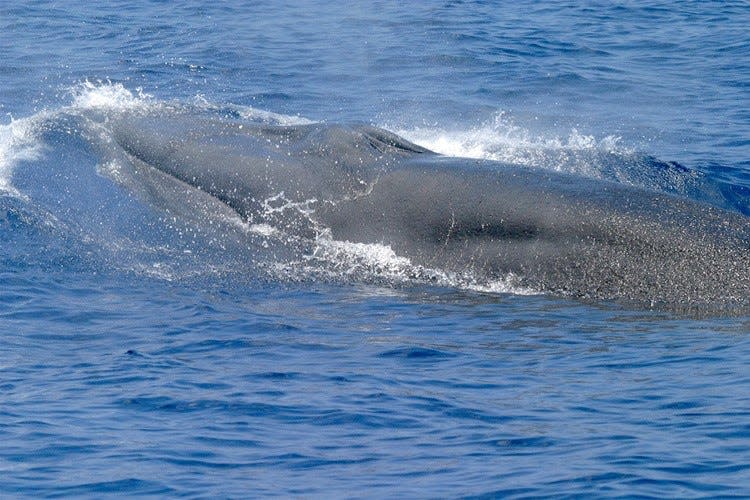Gulf of Mexico whale needs human help to avoid extinction
Just 60 miles off the coast of Northwest Florida, there lies a deep depression along the continental shelf known as DeSoto Canyon, and within its depths resides the world's most endangered species of whale.
The Gulf of Mexico, or Rice's, whale was only identified as a unique species last year, when researchers for the National Oceanic and Atmospheric Administration were able to confirm physical and genetic traits that set it apart from its closest seafaring counterpart, the Bryde's whale.
It is the only species of whale unique to the waters of America, and experts surmise there are fewer than 50 still surviving. By way of comparison, the Atlantic Right Whale, likely the whale species most identified with critical endangerment, boasts a population of approximately 350.

A brand new species of whale on the brink: Tiny group of endangered whales in Gulf of Mexico is a new species
Being that there are so few of them, the Gulf of Mexico whale is seldom seen, according to Christian Wagley, a Pensacola resident and Florida representative of the environmental group Healthy Gulf. It now confines its movements to an area around the deep waters of DeSoto Canyon stretching roughly between Pensacola and Tampa.
"They would have historically ranged along the entire shelf, but they've been pushed to the Northeastern Gulf because it's the quietest part of the Gulf of Mexico," Wagley said. "All the drilling and shipping activity going on in the Central and Western Gulf is like a heavy metal concert to them."
Oil and gas drillinng poses major threats to Gulf of Mexico whale
Growing up to 42 feet long and weighing in at about 60,000 pounds, the Gulf of Mexico whale takes nine years to reach sexual maturity. Its greatest threats are all man-made, according to NOAA Fisheries, and include vessel strikes, ocean noise, energy exploration, development and production, oil spills and responses, entanglement in fishing gear and ocean debris.
Commercial shipping remains comparatively light in the Northeastern Gulf and the state of Florida has thus far successfully fended off efforts to open areas off its coast to oil and gas drilling. But there remains great interest among fossil fuel interests to exploit what are believed to be rich offshore resources.
Seeing the great risk to the Gulf of Mexico whale from continued efforts to find and extract oil from the Eastern Gulf, a group of 100 marine scientists have reached out to the Biden Administration to press the need to preserve "a unique part of the Gulf's natural history" from extinction.

Few on-water measures have been established to protect the whale, the letter, sent to Secretary of the Interior Deb Haaland and Secretary of Commerce Gina Raimondo, said, and "unless significant conservation actions are taken, the United States is likely to cause the first anthropogenic extinction of a great whale species."
Continued oil and gas development in the Gulf represents a "clear, existential threat to the whale's survival and recovery," the scientists, noting that government estimates concluded about 20% of the Gulf of Mexico whale's already severely diminished population had died as a result of the Deepwater Horizon oil spill.
Protecting the whale species, the letter states, requires the exclusion of oil and gas leasing from existing whale habitat and prohibiting air gun surveys used by oil companies to locate fossil fuels below the ocean floor.
"Your Administration is presently considering a new five-year program for offshore oil and gas leasing, as well as a new regulation and related permits and authorizations for seismic surveys in the Gulf of Mexico," the letter from the scientists said. "Continuing with seismic exploration or drilling in the northern Gulf is antithetical to basic principles of conservation and would jeopardize the species' survival and recovery."
Whale mortality: Rare deepwater whale dies on Gulf Islands beach, the 2nd Panhandle whale death this summer
For whales, sound is critical for communication and important for navigation, finding food and avoiding predators, NOAA Fisheries said in a report. Studies indicate eliminating seismic surveying would prevent exposure of the whales and their habitat to what has become the dominant source of noise in the northern Gulf.
With the Gulf of Mexico whale being as critically endangered as it is, Wagley seriously doubts that NOAA could possibly condone seismic surveying anywhere close to its existing known territory.
"This whale is not just endangered, but critically endangered," Wagley said. "The whole purpose of the Endangered Species Act was to protect and recover affected species. That's what we do."
Though President Donald Trump signed an executive order banning oil drilling in the Eastern Gulf of Mexico, Congress is yet to codify a long-standing moratorium on the practice. The last congressional extension of the moratorium expired in June.
Wagley said good news is that the Biden administration has shown no desire to further expand existing drilling.
Aquaculture, offshore wind farms also pose threat to rare whale's survival
But there are other risks mankind poses for the Gulf of Mexico whale.
The scientists also call for aquaculture, offshore wind farms and other new industries to be sited outside of the whales' known habitat, according to a news release from Earthjustice, a nonprofit environmental law organization.
"They also ask for vessels transiting through the whales' habitat to be required to slow down and take other measures to reduce the risk of a fatal collision," the release, which accompanied release of the letter, said.
"The whales rest close to the ocean surface at night, the letter said, "leaving them acutely vulnerable to ship strikes."
Slow it down, save a whale: Ship speed limits sought to protect endangered whales in Gulf near Panhandle
In May 2021, Earthjustice agreed to represent Healthy Gulf, among other groups in filing a petition calling on NOAA Fisheries to set a 10-knot speed limit in an area covering about 11,500 square miles off Florida and Alabama where the whales typically hover near the surface. NOAA has not yet acted on the petition.
Wagley said Healthy Gulf is among several groups angling to have the Gulf of Mexico whale's known territory "and a little extra" designated as critical habitat.
He said there is some hope that as the nation's dependence on fossil fuels diminishes, the noise in the Gulf of Mexico will lessen as well, and Gulf of Mexico whales can return to areas of their former territory they've been forced to abandon.
Others feel it is not too late to save the species from extinction, provided strong measures are quickly taken.
"This extraordinary species can recover, but the situation is urgent," Francine Kershaw, senior scientist at the Natural Resources Defense Council told Earthjustice. "Delay is not an option."
This article originally appeared on Pensacola News Journal: Gulf of Mexico whale is critically endangered and facing extinction

